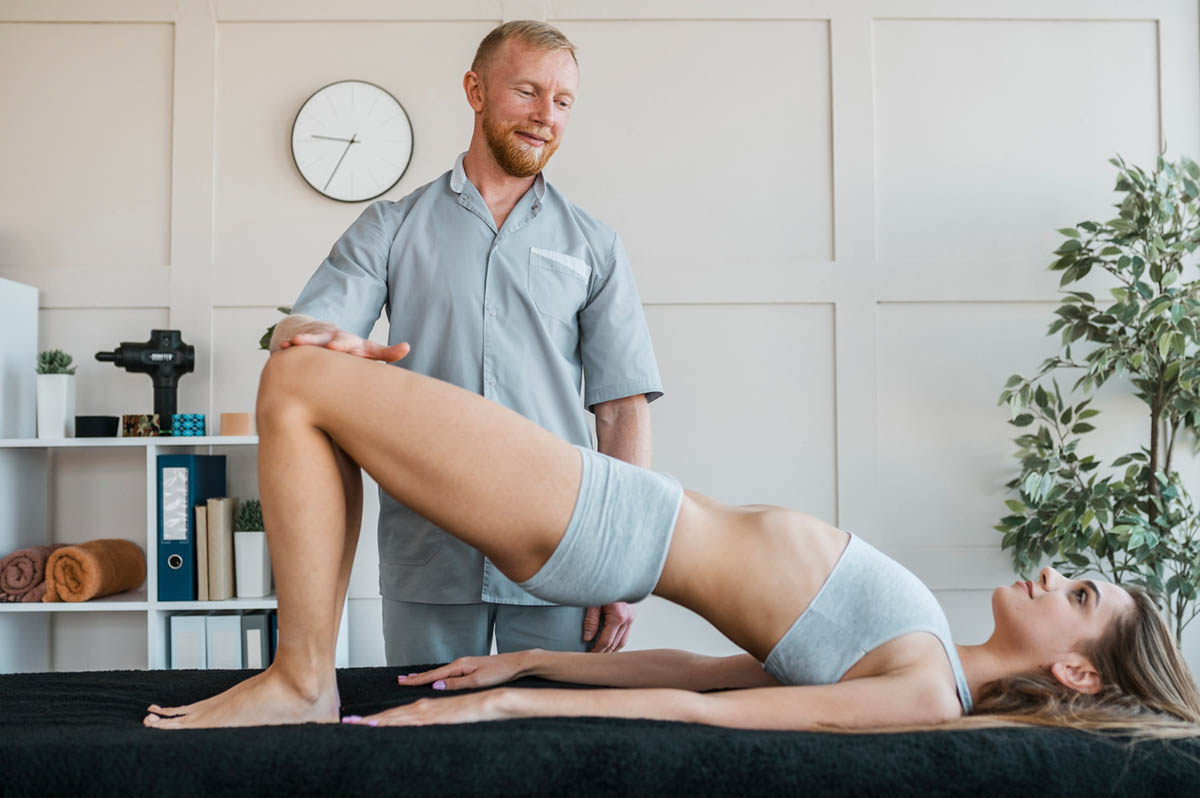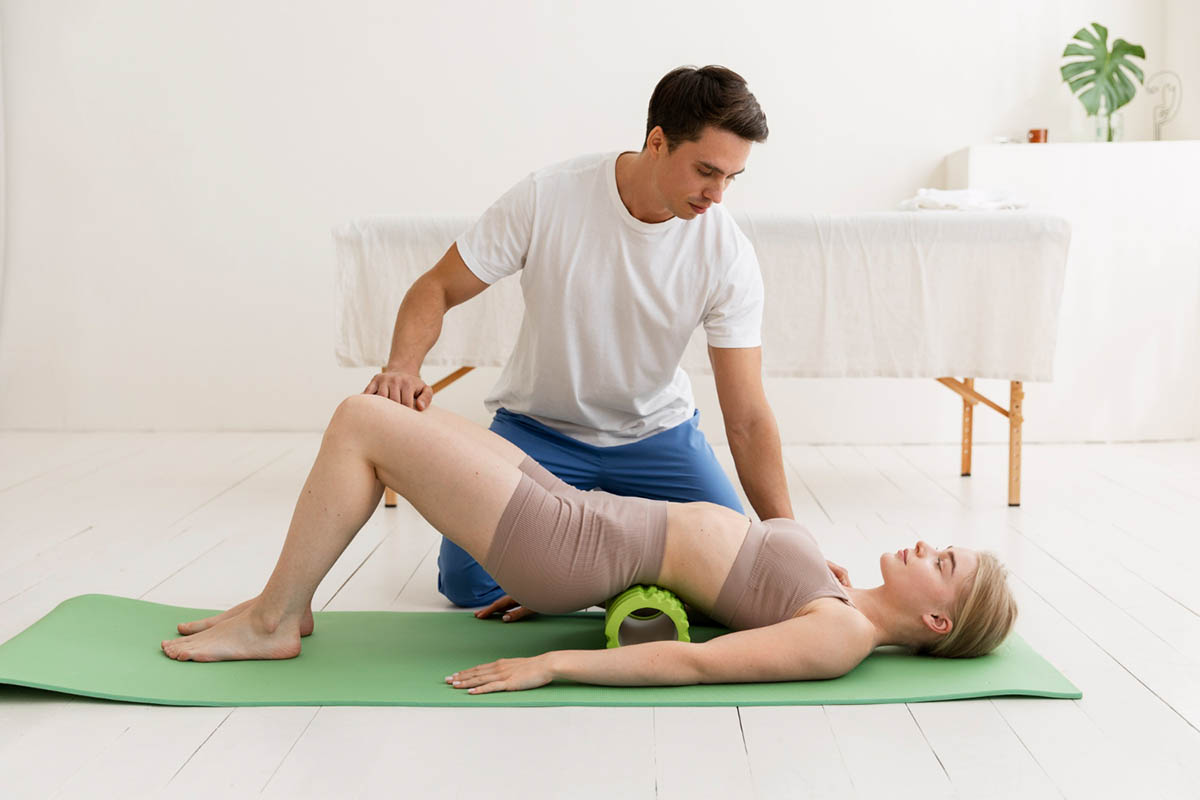The hamstrings are a group of three muscles at the back of the thigh that are important for running, jumping, and overall leg movement. A hamstring strain, a tear or pull in these muscles, is a common injury among athletes and people who engage in strenuous activities.
While typically not life-threatening, a hamstring strain can be quite painful and significantly impact mobility. If you’re experiencing a hamstring strain, seeking physical therapy for hamstring strain can be the key to a full and speedy recovery.
Common Causes of Hamstring Strain
Hamstring strains are a major concern for athletes, accounting for a significant portion of sports injuries. Studies show they represent 12% to 16% of all reported injuries among athletes. Even more concerning is the high reinjury rate, ranging from 22% to 34%.
Understanding the common causes of a hamstring strain can help you prevent future occurrences:
- Overuse and Repetitive Stress: Repeatedly stressing your hamstrings without proper rest can lead to microscopic tears, eventually culminating in strain.
- Sudden or Explosive Movements: Activities like sprinting or jumping from a height put significant strain on your hamstrings, increasing the risk of tears in muscle fibers.
- Poor Flexibility: Tight hamstrings are more susceptible to strain as they have less flexibility to absorb sudden movements.
- Muscle Imbalances: Weak glutes or quads can put unnecessary stress on the hamstrings. This can lead to a strain.
- Inadequate Warm-Up: Skipping a proper warm-up doesn’t prepare your hamstring muscles for physical activity, making them more prone to injury.
- Previous Injuries: Previous hamstring injuries can weaken the hamstring muscles and make them more susceptible to future muscle strains.
Symptoms and Diagnosis of Hamstring Strain
A hamstring strain symptoms can vary depending on the severity of the tear. They often include:
- Pain in the back of the thigh, ranging from mild discomfort to a stabbing, sharp pain
- Difficulty walking, running, or bending down
- Tenderness to the touch
- Bruising
- Weakness in the affected leg
A doctor will typically diagnose a hamstring strain injury through a physical exam and may order an imaging test like an ultrasound or MRI to confirm the severity of the tear.
Importance of Physical Therapy in Hamstring Strain Recovery

Physical therapy (PT) is widely known as an important factor in recovering from a hamstring strain. Here’s why:
Benefits of Physical Therapy:
- Reduced pain and inflammation
- Improved flexibility and range of motion
- Increased muscle strength and stability
- Enhanced balance and proprioception (body awareness)
- Reduced risk of reinjuries
- Faster return to everyday activity
Role of Physical Therapists:
A physical therapist can create or design a personalized rehabilitation program tailored to the severity of your injury and your specific needs. This program will include a combination of:
- Manual therapy techniques like massage and mobilization improve circulation, reduce pain, and improve muscle function.
- Therapeutic hamstring exercises to strengthen the hamstrings, core, and surrounding muscles.
- Stretching exercises to improve flexibility and range of motion.
- Education on proper warm-up and cool-down techniques to prevent future hamstring injuries.
- Guidance on a gradual return to your normal activities.
Physical Therapy Exercises for Hamstring Strain
Here are some common physical therapy exercises for hamstring strain recovery, categorized by their focus:
Hamstring Stretching Exercises:
These exercises should be done gently and pain-free, holding each stretch for 30 seconds and repeating 2-3 times per side.
- Hamstring Wall Stretch: Stand facing a wall with your hands shoulder-width apart. Extend one leg straight back, with the heel flat on the floor, while keeping the other leg bent. Lean your torso forward from the hips, keeping your back straight until you feel a gentle stretch in your hamstring.
- Seated Hamstring Stretch: Sit on the floor with both legs extended. Lean forward from your hips, reaching for your toes with both hands. If you can’t reach your toes, use a strap or towel to assist.
- Standing Hamstring Stretch: Stand with your feet hip-width apart. Hinge at your hips and slowly fold forward, keeping your back straight, until you feel a stretch in your hamstrings. Reach for your shins or toes if possible.
Hamstring Strengthening Exercises:
These hamstring strain exercises should be performed with light weights or resistance bands, gradually increasing intensity as you progress.
- Hamstring Curls: Lie on your stomach with your knees bent and feet flat on the floor. Lift your heels off the floor, squeezing your hamstrings, and hold for a second before lowering them back down.
- Bridges: Lie on your back with your knees bent and feet flat on the floor. Lift your hips off the ground, squeezing your glutes, and hold for a second before lowering back down.
- Single-Leg Deadlifts: Stand with your feet hip-width apart. Hold a weight in each hand (or no weight if you’re a beginner). Keep your back straight, hinge at your hips, and slowly lower your torso, extending one leg straight back behind you. Hold for a second before returning to the starting position.
Additional Supportive Exercises:
These exercises target other muscle groups that is important in supporting your hamstrings and preventing future injuries
Calf Strengthening Exercises:
Strong calves help support the hamstrings and ankles, reducing the risk of future injuries.
- Calf Raises: Stand with your feet shoulder-width apart and raise onto your toes. Hold for a second before lowering your heels back down. You can perform this exercise on a step for added difficulty.
- Seated Calf Stretch: Sit on the floor with your legs extended. Loop a towel around the ball of one foot and hold the ends in your hands. Pull back gently on the towel to stretch your calf muscle, hold for 30 seconds, and repeat on the other side.
Hip and Quad Strengthening Exercises:
Strong hips and quads improve overall leg stability and take stress off the hamstrings.
- Hip Extensions: Lie on your stomach with one knee bent at a 90-degree angle and the other leg straight. Lift your bent leg off the ground, squeezing your glutes, and hold for a second before lowering back down. Repeat on the other side.
- Quad Sets: Sit in a chair or lie on your back with your legs straight. Tighten the muscles in your quadriceps (the muscles on the front of your thigh) and hold for a few seconds. Relax and repeat.
Core Stability and Balance Exercises:
A strong core improves overall stability and helps prevent injuries.
- Planks: Start in a push-up position with your forearms on the floor. Keep your body in a straight line from head to heels, engaging your core muscles. Hold for as long as you can comfortably, and repeat sets.
- Single-Leg Balance: Stand on one leg for 30 seconds, then switch legs. You can hold onto a chair or wall for support if needed.
Plyometric and Return to Sport Exercises:
These exercises are incorporated later in the rehab program to prepare you for a safe return to your desired activity.
- Jumping Jacks: A classic exercise that improves explosiveness and coordination. Start with low-impact jumping jacks and gradually increase intensity as you progress.
- Box Jumps: Step or jump onto a sturdy box of appropriate height and then step or jump back down with control.
Remember: It’s important to consult with a physical therapist before starting any exercise program, especially after an injury. They will assess your specific needs and create a program tailored to your recovery.
How Long Does Hamstring Strain Take to Heal?

Factors Affecting Recovery Time:
The healing time for a hamstring strain depends on several factors, including:
- Severity of the tear: Grade 1 strains (microscopic tears) typically heal within a few weeks, while grade 3 strains (complete tears) can take several months.
- Age and overall health: Younger and healthier individuals generally heal faster.
- Treatment adherence: Following your physical therapy program diligently can significantly accelerate recovery.
Typical Recovery Timeline:
- Grade 1 Strain: 1-3 weeks
- Grade 2 Strain: 4-8 weeks
- Grade 3 Strain: 3 months or more
How Mitchell Holistic Health Can Help
At Mitchell Holistic Health, we understand the frustration and limitations a hamstring strain can cause. Our team of experienced physical therapists is dedicated to helping you recover quickly and safely.
Our Expertise in Treating Hamstring Strains:
Our therapists have extensive experience in treating hamstring strains of all severities. We utilize a combination of manual therapy techniques, therapeutic exercises, and modalities to promote healing and improve function.
Personalized Treatment Plans:
We understand that no two injuries are alike. Based on your individual needs and goals, we create personalized treatment plans and work closely with you to ensure a smooth and successful recovery.
Comprehensive Care Approach:
We take a holistic approach to healthcare, addressing not only your injury but also potential risk factors that may have contributed to it. This may include recommendations for improving flexibility, strengthening core muscles, and proper warm-up/cool-down routines.
Conclusion
A hamstring strain can sideline you from your favorite activities, but with proper care, you can make a full recovery. Physical therapy (PT) is the cornerstone of effective hamstring strain rehabilitation process. Remember, injury prevention is key. By incorporating proper warm-up and cool-down routines, maintaining flexibility, and strengthening your hamstrings, you can significantly reduce your risk of future injury.
Don’t let hamstring-strain injuries hold you back. Consult a good physical therapist and take the initial step toward a swift and complete recovery.
FAQs
Can physical therapy help a pulled hamstring?
Absolutely! Physical therapy is widely known effective treatment for hamstring strains. It can reduce pain, improve flexibility and strength, and help you return to your activities safely.
What is the best way to rehab a hamstring strain?
The best way to rehab a hamstring strain is through a personalized physical therapy program. Your therapist will assess your injury and create a program that includes manual therapy, therapeutic exercises, and education on proper healing techniques.
What is the best therapy for a hamstring?
The best therapy for a strained hamstring includes a comprehensive approach of stretching, strengthening, and supportive exercises guided by a qualified physical therapist. This approach ensures a complete and safe recovery.

